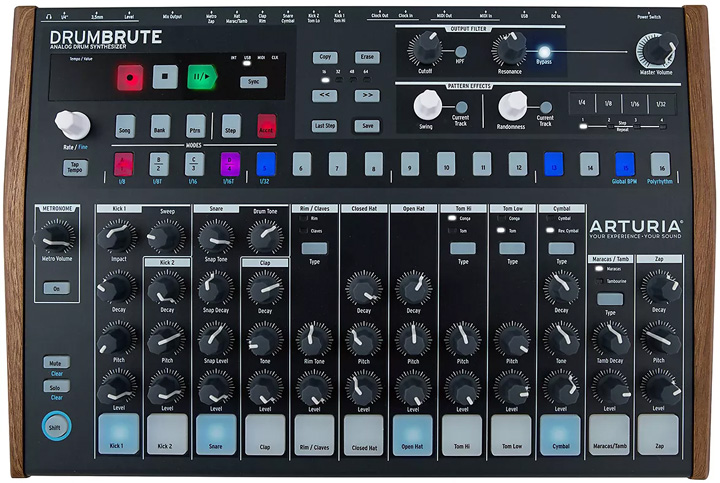
Already established as a leader in plugin recreations of vintage synthesizers, Arturia has expanded their focus in recent years to include new hardware instruments like the Minibrute synthesizer that pack a ton of features and value into solid, affordable, unique instruments.
The Drumbrute, Arturia’s new 17-voice analog drum machine, continues the path established by the “Brute” series by delivering a distinct set of drum sounds in a fun, inspiring package.
The Drumbrute’s Distinct Sounds
I’ve seen other reviewers describe the overall tonal character of the Drumbrute as rough. While the voicing tends toward harder edged sounds, I prefer to describe them as solid.
By this, I mean that each of the sounds – from subby bass drums to crisp snares to disco zaps – offers a well-defined set of frequencies and controls with a distinct character on their own, while acting as a strong foundation for further sound shaping and processing.
The range of sounds is more narrow than a Roland TR-8, which aims to recreate the family of Roland drum machines. The Drumbrute seeks to establish its own distinct voice.
It is perhaps an under-appreciated fact that the classic 808 bass drum sound is often the result of significant processing via overdrive, equalization, and compression. The addition of individual outputs for each sound – a rarity at this price point and a differentiator versus the Roland TR-8 – opens up the Drumbrute as less of a destination and more of a starting point for building your own distinct drum sounds.
Running the clap through a reverb effect brought me instantly into ‘80s LM-1 territory, and a tempo-synced delay on the 606-style metallic hi-hats added even more movement to the Drumbrute’s impressively organic sequencing options.
Arturia provides two distinct bass drum voicings – the first, more aggressive and pitchy and the second, more mellow and sub-focused. The two bass drums complement each other well, even when layered. Using the second bass drum for bottom end and tuning the first for pitch movement and attack, I was able to replicate the huge multi-drum layered sound that many producers painstakingly stack samples in the DAW to achieve.
In a final creative stroke, Arturia added a Steiner Parker high pass/low pass filter to the master output, allowing you to shape the overall character of the Drumbrute while putting instant drum breakdowns and filter sweeps at your fingertips. This adds tremendously to the playability of the instrument, giving you real-time control over where your drum sounds sit in your total mix.
Inspiring Sequencing
I love XoX-style sequencers. There is something about a simple grid of buttons and a blinking light that inspires me to create and tweak rhythm patterns for hours.
The Drumbrute has the most fun percussion sequencer I have ever played. It retains the hands-on, intuitive nature of XoX sequencing, while adding performance and production features that break your beats away from the rigid sequencer grid and transform them into dynamic, evolving, unpredictable rhythms.
First, the Drumbrute offers two modes for programming. You can use the traditional 16-step grid approach with accent velocities available on a per-instrument basis, or you can manually play and record your beats with the 12 rubber pads.
The pads serve multiple functions. They're used to silently select which drum to show on the sequencer by holding “shift” and pressing the pad and adding/subtracting sounds from the Drumbrute’s mute and solo groups. I especially enjoyed building up a complex pattern and then progressively stripping out sounds and rebuilding the beat through creative use of the mute group.

So far so good. And if the Drumbrute sequencing stopped there, it would be a fun, hands-on drum machine. But where the instrument truly distinguishes itself is in its ability to introduce swing, randomness, and polyrhythm on a per sound basis.
That may sound complex, but practically, it means that your clap can have its own swing and groove while the hi-hats play organic, evolving patterns overtop of a rigidly quantized 6-step bass drum pattern.
In effect, the Drumbrute acts more like a real drummer than a drum machine with subtle changes and a constant push and pull to the groove. I found myself setting up simple patterns with a large amount of randomness and then just letting the Drumbrute play, the random rhythmic riffs and motifs serving as instant inspiration for new bass lines and synth melodies.
Best of all, the Drumbrute outputs all of this sequencing via MIDI, so you can use the Drumbrute as a powerful percussion sequencer at the heart of your hybrid studio setup.
